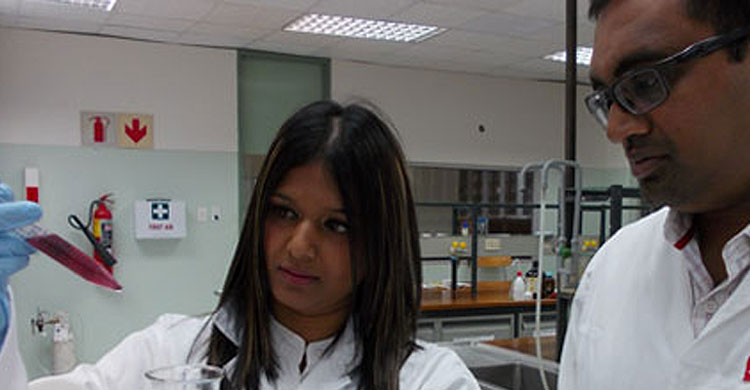
Rekha Dunpall (left) and Professor Neerish Revaprasadu in their lab at the University of Zululand with a sample of their nanoparticles. Image by ScienceLink.
University of Zululand researchers have created a versatile, first-of-its-kind nanoscopic homing system to target cancer cells specifically. In other words, they’ve synthesised a tiny vehicle that would deliver potent drugs only to abnormal cancer cells, while avoiding normal, healthy cells.
The system thus has the potential to overcome one of the major draw-backs of chemotherapy, the best treatment currently available, which distributes a chemical anti-cancer cocktail through-out the body in an untargeted manner.
The researchers behind this innovation, Rekha Dunpall and Professor Neerish Revaprasadu, describe it as a gold-zinc-telluride core-shell nanoparticle system, in a paper published by the Royal Chemistry Society.
Dunpall says the research is novel in a number of ways: in the structure of the nanoparticle, in the combination of materials, and in the method used to synthesise it.
It consists of a gold (Au) core and a zinc-telluride (ZnTe) shell with a capping agent. This particular structural arrangement has not been achieved before anywhere in the world, and they’ve managed to synthesise it at a lower temperature than what is conventional.
At the moment, the researchers are demonstrating the biocompatibility of these nanoparticles with a breast cancer cell line, in order to determine its potential to combat breast cancer. The nanoparticle’s capping agent consists of cysteine, an amino acid that is readily accepted by biological cells, thus lending it a biocompatible nature.
The nanoparticle’s tiny size also makes it more likely that the human body will accept it, according to Dunpall. Averaging only seven nanometres (about 10 000 times less than the width of a hair), the nanoparticle is too small for immune cells to detect, which would allow it to bypass the body’s natural defences.
It is important to note that the nanoparticle itself is not an anti-cancer drug. Rather, the drug of choice is attached to the surface of the nanoparticle. “Think of the nanoparticle as a versatile template; one that can be modified however you like to perform the necessary function or target a specific type of cancer,” explains Dunpall.
With regard to how the nanoparticle is targeted at different cells, Dunpall says, “the cells from your pancreas are not the same as the cells from your heart. They have different functions and they have different cellular receptors. We attach a complementary ligand (a small protein such as a hormone) that will only attach to a specific kind of cell. You can think of it as a lock-and-key system.”
Thus far, the researchers have found that the nanoparticles worked as intended in all the cell lines tested and were relatively non-toxic.
Dunpall says that due to its template nature, the nanoparticle can be used in all sorts of therapies beyond cancer, including gene therapy and the delivery of DNA fragments to cells.
In future, Dunpall and her colleagues would like to study the drug delivery capacity and efficacy of the nanoparticles in different cell lines and in animals. There are also plans to commercialise the product once it passes the clinical studies that will follow this initial research.
“Our work is a proof of concept to show that the process works,” says Revaprasadu.
Professor Neerish Revaprasadu is the SARCHi Chair of Nanotechnology and Professor of Chemistry at the University of Zululand. He has published 90 articles in peer-reviewed journals and has presented his work at more than 40 international conferences with his publications cited more than 1200 times.
Ms. Rekha Dunpall is a University of Zululand alumnus, she holds a BSc Medical Science, BSc Biochemistry (Hons), MSc Biochemistry. She is currently a final year PhD Biochemistry candidate working in the multidisciplinary domain of nanotechnology.